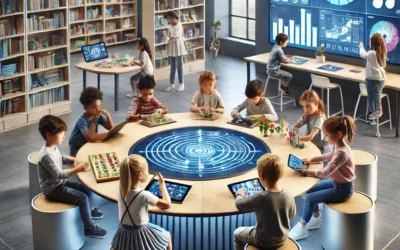Solutions to enhance cognitive flexibility can significantly improve your teaching practices and student learning outcomes. By implementing advanced classroom strategies and technologies, you can cultivate an adaptive learning environment that encourages critical thinking and creativity. This guide will walk you through effective methods to integrate these solutions into your classroom, empowering both you and your students to navigate challenges with ease and flexibility.
Understanding Cognitive Flexibility
Definition and Importance
Cognitive flexibility refers to your ability to adapt your thinking and behavior in response to new, changing, or unexpected events. It plays a vital role in problem-solving, decision-making, and learning. By enhancing cognitive flexibility, you can improve your capacity to view a situation from various perspectives, thereby fostering creativity and analytical thinking. This skill allows you to switch between tasks effectively, approach challenges with an open mind, and embrace multiple solutions to problems.
The importance of cognitive flexibility in educational settings cannot be understated. It enables you to navigate complex material, understand diverse viewpoints, and adjust to varying teaching styles. As you cultivate cognitive flexibility, you position yourself to be more successful not only in the classroom but in real-world scenarios where adaptability is important.
Factors Affecting Cognitive Flexibility
Factors that can influence your cognitive flexibility include various environmental, social, and psychological components. These may encompass your learning environment, peer interactions, teacher support, and even the methodologies employed in classroom settings. You might find that an encouraging atmosphere where collaboration and open dialogue thrive can enhance your ability to adapt your thought processes. Conversely, rigid educational systems that do not allow room for innovation may hinder your cognitive flexibility. Consider the following factors:
- Your learning environment’s structure and support.
- The variety of pedagogical approaches used by your educators.
- Your opportunities for peer collaboration and feedback.
Assume that you’re regularly exposed to diverse perspectives and educational activities that challenge your usual way of thinking; these experiences will significantly contribute to enhancing your cognitive adaptability.
Flexibility in thought is not just a natural trait; it can be cultivated through deliberate practice and continuous exposure to new ideas. Engaging with varying viewpoints, participating in dynamic discussions, and taking on different roles in group projects can all enhance your cognitive flexibility. It is also beneficial to push the boundaries of your comfort zone by exploring unfamiliar subjects, which will stimulate your cognitive processes. Consider the following:
- Your willingness to explore unfamiliar topics or activities.
- Your ability to approach challenges with an open mind.
- Your commitment to continuous learning and self-improvement.
Assume that you actively seek out such experiences, and you will likely see significant growth in your cognitive flexibility over time.
Advanced Classroom Solutions
While traditional teaching methods have their place, advancing your classroom solutions to enhance cognitive flexibility can yield significant benefits. These solutions not only foster an engaging environment but also prepare students to adapt to a rapidly changing world. You can explore a variety of advanced classroom solutions, including:
- Interactive learning platforms
- Personalized learning experiences
- Gamification of lessons
- Virtual and augmented reality integration
- Flexible seating arrangements
| Advanced Classroom Solutions | Benefits |
|---|---|
| Interactive learning platforms | Enhanced student engagement |
| Personalized learning experiences | Addressing individual learning styles |
| Gamification of lessons | Increased motivation and interest |
| Virtual and augmented reality integration | Realistic simulations enhancing understanding |
| Flexible seating arrangements | Promoting collaboration and comfort |
Technology Integration
Integration of technology in your classroom is vital for fostering an environment that enhances cognitive flexibility. By utilizing tools such as educational apps, digital whiteboards, and learning management systems, you can create a dynamic and interactive learning experience. The use of technology not only supports differentiated instruction but also enables students to take charge of their learning process. As they navigate various digital tools, they cultivate the ability to shift perspectives and adapt their thinking.
Incorporating technology also encourages your students to develop critical thinking and problem-solving skills. For instance, you might use simulation software to challenge them with real-world scenarios requiring flexible thinking. By actively engaging with technology, your students will learn to embrace change and develop adaptability, vital skills for success in an ever-evolving world.
Collaborative Learning Techniques
Clearly, employing collaborative learning techniques in your classroom is instrumental in enhancing cognitive flexibility. When students work together in diverse groups, they are exposed to a variety of perspectives and problem-solving approaches, which broadens their thinking. By facilitating group discussions, peer reviews, and project-based activities, you encourage your students to consider multiple viewpoints and adapt their responses based on peer feedback.
Classroom environments that thrive on collaboration allow students to engage in shared learning experiences. This not only helps them to build social skills but also instills a sense of community. It is through these collaborative engagements that students learn to negotiate ideas, adapt to different roles, and develop resilience in the face of challenges, all of which are key components of cognitive flexibility.
How-to Enhance Cognitive Flexibility
Some of the most effective ways to enhance cognitive flexibility in the classroom include implementing tailored approaches that address the varying needs of your students. By understanding that not all learners respond the same way to instruction, you can adjust your teaching methods. This adaptability not only encourages students to approach problems from multiple angles but also builds their confidence in navigating complex tasks. A flexible classroom allows students to shift their thinking and apply their knowledge in different contexts, which is key to developing cognitive agility.
Implementing Adaptive Learning Strategies
Assuming that you are aware of the diverse capabilities of your learners, incorporating adaptive learning strategies can significantly boost cognitive flexibility. These strategies allow you to personalize the learning experience based on real-time data about student performance. By using technology that tracks students’ progress and provides tailored content, you ensure that each learner engages with material that suits their current level. This way, they can experience challenges that are neither too easy nor too difficult, fostering a growth mindset and encouraging adaptable thinking.
Creating Diverse Learning Environments
Learning environments that embrace diversity in teaching methods, materials, and interactions are crucial for fostering cognitive flexibility. By incorporating group projects, multimedia resources, and hands-on activities, you create a rich tapestry of experiences that encourage students to draw connections between different concepts. This variety not only keeps students engaged but also allows them to practice shifting their perspectives, an crucial component of cognitive flexibility.
It’s important to prioritize inclusivity and representation in your classroom materials as well. By exposing students to various viewpoints, cultures, and ideas, you open the door for them to rethink their assumptions and approach problems from multiple angles. Additionally, ensuring a safe and supportive environment encourages students to express their thoughts freely, further enhancing their ability to flexibly navigate various cognitive challenges.
Tips for Educators
Despite the challenges that come with fostering cognitive flexibility in the classroom, you can adopt a variety of advanced solutions that will enhance your students’ adaptability and problem-solving abilities. Here are some effective strategies to implement:
- Integrate project-based learning activities.
- Encourage group discussions where diverse opinions are valued.
- Facilitate role-playing exercises to explore different perspectives.
- Use technology to create interactive learning experiences.
- Offer choices in assignments to empower student decision-making.
The importance of these strategies cannot be overstated, as they provide a framework that enhances your students’ cognitive flexibility.
Encouraging Open-mindedness
To effectively encourage open-mindedness in your classroom, create an environment where students feel safe to express their thoughts and ideas. Promote discussions that challenge students to consider viewpoints different from their own. This not only helps them to appreciate diverse perspectives but also trains them to approach problems with a flexible mindset. Use prompts that require students to justify their opinions while being open to constructive criticism, thus making them more adaptable thinkers.
Developing Problem-solving Skills
On the other hand, developing your students’ problem-solving skills is a vital component of enhancing cognitive flexibility. Incorporate real-world challenges and puzzles into your lesson plans, encouraging students to collaborate in finding solutions. This collaborative effort not only stimulates critical thinking but also allows them to learn from one another, creating a rich learning experience that helps build resilience in the face of challenges.
A well-structured problem-solving curriculum can include activities such as case studies, simulations, or design thinking exercises, where students actively engage in identifying problems, brainstorming solutions, and iterating on their ideas. By providing opportunities for trial and error in a supportive environment, you enable your students to develop persistence and adaptability, which are necessary qualities for navigating complex issues both in academic contexts and in everyday life.
Monitoring Progress
After implementing advanced classroom solutions, it is crucial to continuously evaluate and monitor the progress of your students. This ongoing assessment helps you understand how well your students are developing their cognitive flexibility skills. By analyzing various data points, you can tailor your teaching strategies to meet the diverse needs of your learners and ensure that they are fully engaged in their learning process. Utilizing effective monitoring techniques will enable you to track improvements and identify areas that require additional support, helping you create a more responsive learning environment.
Assessment Techniques
Progress can be measured through both formative and summative assessment techniques. Formative assessments—including quizzes, class discussions, and reflective journals—allow you to gauge student understanding in real time and adjust your instruction accordingly. Summative assessments, such as standardized tests and project-based evaluations, provide a comprehensive overview of your students’ cognitive flexibility as they engage with complex problems. By employing a mix of these techniques, you can collect a rich dataset that reflects not only academic performance but also cognitive adaptability.
Adjusting Strategies Based on Feedback
Techniques for adjusting your strategies based on feedback require you to stay attuned to the signals your students send during the learning process. By analyzing their responses to assessments and observing their behavior during activities, you can identify trends and patterns that inform your instructional approach. Regular check-ins and surveys can also provide valuable insights into how students perceive their learning experiences, allowing you to modify your strategies as needed. For instance, if you notice that a particular group is struggling with a specific concept, you might incorporate alternative teaching methods such as hands-on activities or collaborative learning sessions to enhance their understanding.
Monitoring your students’ progress is an ongoing commitment that involves observing their growth, adapting your strategies, and fostering an environment of open communication. By being proactive in collecting and analyzing student feedback, you can create a dynamic classroom atmosphere where cognitive flexibility flourishes. This adaptability in your approach not only benefits your students but also reinforces your role as an effective educator who is responsive to the evolving educational landscape.

Resources for Further Learning
Now that you are equipped with strategies to enhance cognitive flexibility in your classroom, you might be eager to investigate deeper into this fascinating subject. There are numerous resources available that can expand your understanding and provide practical applications for your teaching. By engaging with these materials, you can enrich your knowledgebase and discover new techniques to implement in your educational environment.
Recommended Readings
You can benefit from a selection of books and articles that discuss cognitive flexibility and its impact on education. Titles such as “Mindset: The New Psychology of Success” by Carol S. Dweck and “The Power of Mindful Learning” by Ellen J. Langer offer valuable insights into how flexibility in thinking can be cultivated within your students. Additionally, scholarly articles found in educational journals provide research-based evidence and practical case studies that can guide your approach.
Online Tools and Platforms
The rise of digital technology has introduced a plethora of online tools and platforms that can help you enhance cognitive flexibility in your classroom. Websites like Nearpod and Flipgrid allow you to create interactive lessons that encourage students to think critically and collaboratively. Furthermore, platforms offering game-based learning, such as Kahoot! or Quizizz, facilitate an environment where learners can adapt and respond to various challenges, strengthening their cognitive flexibility skills in an engaging way.
Resources like Edpuzzle and Seesaw also provide opportunities for formative assessment through interactive media that stimulate students’ ability to switch between different contexts and viewpoints. Utilizing these platforms, you foster a dynamic learning atmosphere where adaptability is not just taught but experienced. Embracing these online tools will significantly contribute to developing your students’ cognitive flexibility and equipping them with important skills for the future.
To Wrap Up
As a reminder, enhancing cognitive flexibility in your classroom requires a multi-faceted approach that integrates advanced solutions tailored to meet the varied needs of your students. By incorporating technology, adaptive learning platforms, and interactive activities, you can create an environment that fosters open-mindedness and adaptability. Engaging your students in problem-solving tasks that require them to shift their thinking and apply different strategies not only equips them with imperative life skills but also encourages a love for learning.
Additionally, cultivating a growth mindset among your students is imperative for promoting cognitive flexibility. You can achieve this by providing constructive feedback that emphasizes effort and process rather than solely outcome. Encouraging collaboration and discussions that challenge your students’ perspectives can also lead to a deeper understanding and appreciation of diverse viewpoints. By adopting these advanced classroom solutions, you enable your students to thrive in a dynamic world, better preparing them for future academic and personal challenges.
FAQ
Q: What are advanced classroom solutions that can help enhance cognitive flexibility?
A: Advanced classroom solutions encompass various innovative teaching strategies and technologies designed to create a dynamic learning environment. These solutions include interactive learning platforms, multimedia resources, and flexible seating arrangements that promote active engagement. Incorporating gamified learning experiences and collaborative projects can also stimulate critical thinking and adaptability among students, enhancing their cognitive flexibility.
Q: How can educators implement strategies to foster cognitive flexibility in the classroom?
A: Educators can implement several strategies to promote cognitive flexibility. First, they can design lesson plans that integrate open-ended questions and problem-solving tasks, allowing students to explore multiple perspectives. Additionally, incorporating diverse teaching methods, such as group discussions, role-playing, and technology-assisted learning, can cater to different learning styles and encourage adaptability. Regular opportunities for reflection on learning processes can also help students recognize their thinking patterns and adjust accordingly.
Q: What role do assessments play in enhancing cognitive flexibility in students?
A: Assessments are fundamental in enhancing cognitive flexibility as they provide insights into students’ understanding and adaptability. Formative assessments, such as quizzes, peer evaluations, and self-assessments, can help educators identify areas where students may struggle with flexible thinking. By incorporating a variety of assessment types, including project-based assessments and presentations, teachers can encourage students to apply their knowledge in different contexts, fostering a mindset that values flexibility and creative problem-solving.



0 Comments